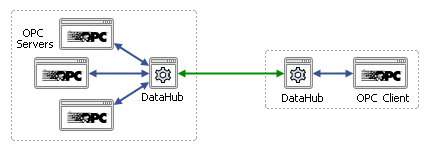| OPC DataHub™ : Version 6.4 | ||
|---|---|---|
 | Chapter 2. OPC Tunnelling |  |
Tunnelling by itself greatly enhances the usefulness of OPC. However, you can get even more benefit out of the OPC DataHub by combining tunnelling with OPC bridging and/or aggregation.
OPC bridging means linking data from one OPC server to another OPC server, usually on a single machine. However, you can bridge two OPC servers over a network using a tunnelling connection:

This scenario involves setting up the DataHubs on both machines to act as OPC clients to the respective OPC servers. The DataHubs then interface with each other over a TCP tunnelling connection. Configure the DataHub on the machine with the most uptime to be the tunnelling master and the other DataHub to be the tunnelling slave. We recommend that all bridges be configured on just one of the DataHubs.
OPC aggregation means combining data from multiple OPC servers into a single server. Here are a few ways that tunnelling can be combined with aggregation:
Aggregation from remote servers uses tunnelling to bring the data from several OPC servers on different machines into one client.

This scenario involves setting up three OPC server machines and one OPC client machine for tunnelling. Aggregation takes place on the OPC client machine.
Remotely connecting to several servers does tunnelling to connect a group of servers on a single machine to a remote client.

This scenario requires configuring the DataHub for each of the three different OPC servers, and setting up the OPC client machine for tunnelling. Aggregation takes place on the OPC server machine.
Remotely connecting many clients uses tunnelling to bring data from a single server to many remote clients.

This scenario involves setting up one OPC server machine and three OPC client machines for tunnelling. Aggregation takes place on the OPC server machine.
Many other combinations can be made. These are just a few to get you started.
For more information about using the OPC DataHub to aggregate clients or servers, please refer to Chapter 3, OPC Aggregation.
Copyright © 1995-2010 by Cogent Real-Time Systems, Inc. All rights reserved.